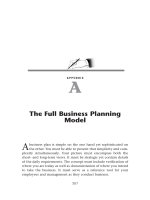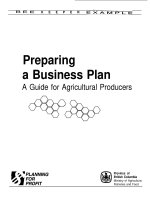WRITING A BUSINESS PLAN
Bạn đang xem bản rút gọn của tài liệu. Xem và tải ngay bản đầy đủ của tài liệu tại đây (156.35 KB, 17 trang )
WRITING A BUSINESS PLAN
No matter what kind or size of business you are starting, it is very important to create a
business plan. It will be your road map to success. It communicates your
understanding of the business and it makes reasonable assumptions and forecasts of
sales, expenses, and cash flow.
When writing your business plan, it is important to keep in mind for whom you are writing
it. If you are writing a business plan for an investor or a bank you should assume that
they know nothing about your business and industry. Also, keep your business plan
short and to the point. If you were a loan officer, would you rather read a sixty-page
plan or a seven-page plan? Bankers and investors want just the facts - all of the facts -
but just the facts. If, on the other hand, you are writing a business plan just for yourself,
you should construct it to suit your needs. It should indicate your goals and what
strategies you will put in place to achieve the goals.
If you are writing a business plan for an investor or a bank, the following information and
format is recommended (Note: This information is also important for an informal
business plan).
EXECUTIVE SUMMARY
This is a one page summary of your business plan. It should include:
• A very short history of the business.
• The amount and type of financing required.
• The amount of equity (money) already invested and collateral offered.
• The purpose for which the money will be used.
• A very short summary of owner experience in industry and business viability.
TABLE OF CONTENTS
The table of contents lists the major divisions of your plan. The page numbers where
each section begins should also be indicated.
I. The Business
II. Products/Services Offered
III. Market Analysis
IV. Marketing Plan
V. Management and Personnel
VI. Financial Data
A. Sources and Uses of Funds
B. Balance Sheet
C. Cash Flow Projection
D. Financial Assumptions
VII. Appendices and Supporting Documents
THE BUSINESS
This section describes your business and the industry you are in. It should include :
• The current status of the business (start-up, existing, acquisition).
• The business structure (sole-proprietor, corporation) and ownership structure.
• Products/services your business offers.
• Suppliers of your products.
• What differentiates your business from your competitors.
• Description of business location and hours of operation.
• Short and long term goals.
PRODUCTS/SERVICES OFFERED
This section describes the products and/or services that your business provides. It
should be written so that a lay person can easily understand. Write a short paragraph
about your primary products/services and indicate:
• A short description of products/services.
• Price structure of the product/service.
• Percentage of total gross sales that the product/service comprises.
• Which products/services are the most profitable.
• Any changes you foresee.
You should also include a list of other products/services and any special or unique
features.
MARKET ANALYSIS
This section is one of the most important. It is imperative that you demonstrate that you
are knowledgeable about your business’s environment. The primary components of this
section are:
The Industry -
• What specific industry are you in?
• What are the major trends?
• Is the industry in a growth phase?
Hint: Trade associations are great sources of industry information.
Your Customers -
• Who are your customers? (individuals, small businesses, etc.)
• What is their demographic makeup? (age, sex, profession, etc.)
Market Size -
• What is your market area? (Example: 20 mile radius of Waldorf)
• How many potential customers are within your market area?
Competition -
Write a short paragraph on each of your primary competitors and discuss:
• How long they've been in business.
• Approximately how much business they do.
• Their strengths and weaknesses.
• Why customers will go to you instead of your competitor.
MARKETING PLAN
Now that you have identified your target market, this section allows you to explain how
you will get these customers to purchase your products or services. You should write a
short paragraph on each method of advertising and include:
• A short description of the advertising method (flyers, radio spots, newspaper ads,
etc.).
• The frequency that it will be used.
• The cost of the method of advertising.
• How many potential customers will be reached.
MANAGEMENT AND PERSONNEL
Your business is only as strong as the people running it. This section showcases the
key members of your team and their responsibilities. A short paragraph should be
written on each position in your company. Include for each position:
• The position title.
• The name of the person in the position.
• A short description of the person’s business background and experience.
• A description of the person’s responsibilities.
For less significant positions or positions that are not yet filled, only the position title and
description are necessary. You will also want to include your team of professionals;
your accountant, attorney, SBDC counselor, etc.
Tip: Organizational charts are very helpful.
FINANCIAL DATA
This is the most important part of your plan. The discussions contained in the other
sections of this plan should be reflected in the financial information.
Sources and Uses of Funds
This basically states where the businesses funds will come from and where they will be
spent. It should look similar to this:
Sources:
Cash from owner......................................................................$__________
Investor contribution.................................................................$__________
Bank Loan................................................................................$__________
Total.....................................................................................$__________
Uses:
Remodel Space........................................................................$__________
Equipment ...............................................................................$__________
Rent Deposit.............................................................................$__________
Utilities Deposits.......................................................................$__________
Office Supplies.........................................................................$__________
Initial Inventory.........................................................................$__________
Working Capital........................................................................$__________
Total.....................................................................................$__________
The totals of the sources and uses of funds must be equal.
Balance Sheet
The balance sheet states the businesses assets, liabilities, and net worth. It is a
snapshot in time of your business’s financial strength. It should look like this:
Assets:
Cash.........................................................................................$__________
Accounts Receivable................................................................$__________
Inventory...................................................................................$__________
Real Estate...............................................................................$__________
Fixtures, Equipment.................................................................$__________
Other Assets.............................................................................$__________
Total.....................................................................................$__________
Liabilities:
Short-Term Notes Payable.......................................................$__________
Accounts Payable.....................................................................$__________
Taxes Owed.............................................................................$__________
Long-Term Notes Payable.......................................................$__________
Total.....................................................................................$__________
Net Worth:................................................................................$__________
Total Assets minus total Liabilities must equal Net Worth.
Cash Flow Projection
The cash flow projection shows how cash flows into and out of your business on a
monthly basis. This table will be of particular interest to the bank as it shows that your
business will have the ability to make regular monthly note payments in addition to your
other expenses. (See sample plan)
Financial Assumptions
This section explains how you came up with the numbers in your cash flow projection.
You can’t just pull numbers out of the air; they must be validated by your research. Any
category that would not be obvious to the reader should be explained. An example of
this section would look like this:
Gross Sales - Projected sales are based on (1) the average sales of four hardware
stores in our same market area, (2) national average of gross sales per square foot for
hardware stores, and (3) independent surveys of 12 hardware stores in similar
demographic areas.
Cost of Goods Sold - The cost of goods is based on an 80% average markup on
inventory.
Payroll - Payroll expense includes a $24,000 salary for the owner ($2000/mo.), and two
part-time clerks working 20 hours per week at $6.00 per hour.
At the end of the assumptions page, discuss the potential risks (new competitors, new
technologies, bad weather, etc.) your business could face and how you plan to deal with
these risks, if applicable.
APPENDICES AND SUPPORTING DOCUMENTS
This section should contain any other relevant information regarding your business. It
should include:
• Corporate, LLC, or partnership documentation.
• Owner Resumes
• Letters of recommendation
• Copies of leases, contracts, building blueprints, etc.
• Owner personal financial statements
• Two years of owner’s personal tax returns
• Three years of business tax returns (if existing business)
Bob’s Hot Dogs
Sample Business Plan









